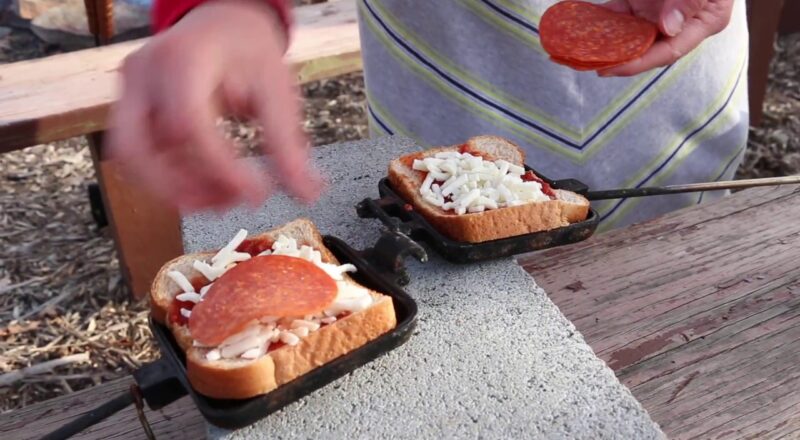When it comes to enjoying the great outdoors, nothing beats the experience of cooking with a pie iron. This versatile cooking tool is perfect for creating delicious meals while camping, in the backyard, or during any outdoor adventure. Whether you are a seasoned pro or a novice camper, understanding pie iron cooking tips and safety guidelines can enhance your outdoor culinary experience.
In this comprehensive guide, we’ll dive deep into everything you need to know about pie iron cooking. From understanding the basics to exploring advanced techniques, we’ve got you covered. Ensuring safety while using pie irons is not only crucial but elevates the whole cooking experience. Let’s explore these guidelines together for a safe and savory outdoor adventure!

What is a Pie Iron?
The pie iron, also known as a camp cooker, pudgy pie maker, or sandwich toaster, is a simple yet ingenious cooking tool that allows you to prepare sandwiches, pies, and many other delightful dishes over an open flame. It consists of two hinged cast iron or aluminum plates with long handles, which can be closed to form a sealed cooking cavity.
Types of Pie Irons
Different materials and shapes of pie irons cater to diverse cooking needs. The three primary types are:
- Cast Iron Pie Irons: Known for their durability and excellent heat retention. A favorite among frequent campers.
- Aluminum Pie Irons: Lightweight, making them ideal for backpackers.
- Non-Stick Pie Irons: Easier to clean, though they may not provide the same flavor as cast iron.
Choosing the right pie iron depends on how you plan to use it and the weight you can carry.
Pie Iron Cooking Tips
- Preheat Your Pie Iron: Always preheat your pie iron over the fire before placing the ingredients. It helps to create a perfect crust.
- Be Generous with Oils: Use butter or oil to coat the inside of the pie iron to prevent sticking, especially for cast iron types.
- Choose the Right Ingredients: Opt for ingredients that cook well together and enhance authentic flavors.
- Monitor Cooking Time: Keep a close watch on the time as different ingredients require varied cooking durations.
- Flip for Even Cooking: Regularly flip the pie iron to ensure the contents cook evenly and prevent burning.
Safety Guidelines
- Inspect the Pie Iron: Before each use, check for any damages or signs of wear.
- Use Heat-Resistant Gloves: Always use gloves to handle hot pie irons to prevent burns.
- Secure the Handles: Ensure that the handles are properly attached and secure to avoid spills.
- Mind the Heat Source: Keep the pie iron safely away from the direct, intense flames to avoid overheating.
- Clean Regularly: Maintain cleanliness of your cooking tools to prevent food residue build-up which could cause contamination.
Cleaning Your Pie Iron
Regular cleaning extends the life of your pie iron. Start by allowing it to cool down, then gently scrub with a brush. For stubborn residues, warm water helps in loosening the crumbs. Avoid using harsh detergents on cast iron as it could strip the seasoning.
For more detailed instructions on maintaining your camp grill and other camp cookware, you might find this article on cleaning and maintenance useful.
Advanced Pie Iron Techniques
- Experiment with Different Recipes: Try new and interesting recipes like pizzas, desserts, or breakfast delights. Explore some amazing recipes at Fresh Off the Grid for inspiration.
- Multi-Iron Usage: For larger groups, use multiple pie irons to cook different dishes simultaneously.
- Adjusting Cooking Methods: Experiment with different heat levels by adjusting the distance of the pie iron from the fire.
Benefits of Using a Pie Iron
Pie irons offer an unparalleled cooking experience. They are:
- Versatile: Suitable for sandwiches, pies, breakfasts, and many more dishes.
- Portable: Easy to carry on all camping trips.
- Durable: Known for their long-lasting material, ideal for outdoor activities.
Common Mistakes to Avoid
- Skipping the Preheat: Always preheat before cooking to help seal in the flavors.
- Overloading Ingredients: Avoid overfilling the iron to prevent spillage.
- Cooking on High Flames: Opt for a steady fire to cook evenly without burning.
Improving Safety While Cooking
Upgrade your safety by investing in gadgets like fire gloves, a cooking stand, and maintaining an appropriate distance from the campfire. Safety first ensures a fun cooking experience.
For more tips on cooking safely in the wild, read about building your own DIY campfire tripod grill.
Choosing the Right Pie Iron
Select a pie iron based on your camping needs and preferences. Consider weight, material, and non-stick features to make a well-informed choice.
Preparing Ingredients for Pie Iron Cooking
Choose simple yet flavorful ingredients. Pre-chop vegetables and store in airtight containers, ready to use. Pre-planning ingredients ensures swift meal preparation.
Pairing with Camp Cookware
Pie irons can be paired with other camp cookware like grills, giving you the versatility to prepare delicious meals. Learn more about compact grill options here.
Conclusion
Cooking with pie irons offers countless possibilities for creating delicious meals outdoors. With these Pie Iron Cooking Tips and Safety Guidelines, you’re better equipped to prepare tasty dishes while ensuring safety. Embrace the opportunity to experiment with recipes and relish the flavorful results!

FAQs
- What materials are pie irons made of? Pie irons are generally made from cast iron or aluminum. Each has its own benefitscast iron retains heat well, while aluminum is lightweight.
- How do I maintain a cast iron pie iron? Clean your cast iron regularly after each use and apply a thin layer of oil to prevent rusting. Avoid using soap directly on the iron.
- What are some common pie iron recipes? Popular recipes include grilled cheese, quesadillas, and sweet fruit pies. For recipe inspiration, check out this resource on pie iron recipes.
This article contains affiliate links. We may earn a commission at no extra cost to you.

